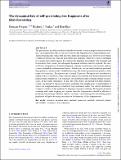The dynamical fate of self-gravitating disc fragments after tidal downsizing
Abstract
The gravitational instability model of planet/brown dwarf formation proposes that protostellar discs can fragment into objectswith masses above a few Jupiter masses at large semimajor axis. Tidal downsizing may reduce both the object mass and semimajor axis. However, most studies of tidal downsizing end when the protostellar disc disperses, while the system is embedded in its parent star-forming region. To compare disc fragment descendants with exoplanet and brown dwarf observations, the subsequent dynamical evolution must be explored. We carry out N-body integrations of fragment-fragment scattering in multi-object star systems, and star systems embedded in substructured clusters. In both cases, we use initial conditions generated by population synthesis models of tidal downsizing. The scattering simulations produce a wide range of eccentricities. The ejection rate is around 25 per cent. The ejecta mass distribution is similar to that for all objects, with a velocity dispersion consistent with those produced by full hydrodynamic simulations. The semimajor axis distribution after scattering extends to parsec scales. In the cluster simulations, 13 per cent of the objects are ejected from their planetary system, and around 10 per cent experience significant orbit modification. A small number of objects are recaptured on high-eccentricity, high-inclination orbits. The velocity distribution of ejecta is similar to that produced by fragment-fragment scattering. If fragment-fragment scattering and cluster stripping act together, then disc fragmentation should be efficient at producing free-floating substellar objects, and hence characterizing the free-floating planet population will provide strong constraints on the frequency of disc fragmentation.
Citation
Forgan , D , Parker , R J & Rice , K 2015 , ' The dynamical fate of self-gravitating disc fragments after tidal downsizing ' , Monthly Notices of the Royal Astronomical Society , vol. 447 , no. 1 , pp. 836-845 . https://doi.org/10.1093/mnras/stu2504
Publication
Monthly Notices of the Royal Astronomical Society
Status
Peer reviewed
ISSN
0035-8711Type
Journal article
Description
DF and KR acknowledge support from STFC grant ST/J001422/1. DF also acknowledges support from the ECOGAL ERC Advanced Grant Programme. RJP acknowledges support from the Royal Astronomical Society in the form of a research fellowship.Collections
Items in the St Andrews Research Repository are protected by copyright, with all rights reserved, unless otherwise indicated.

